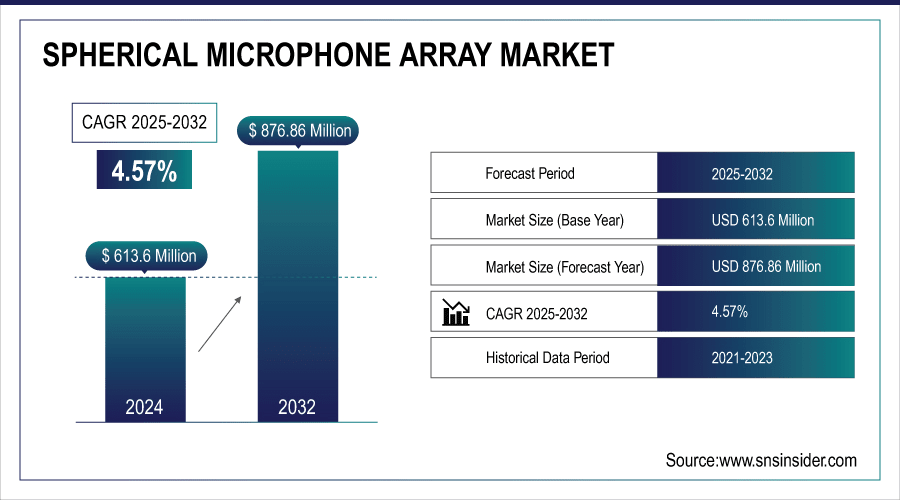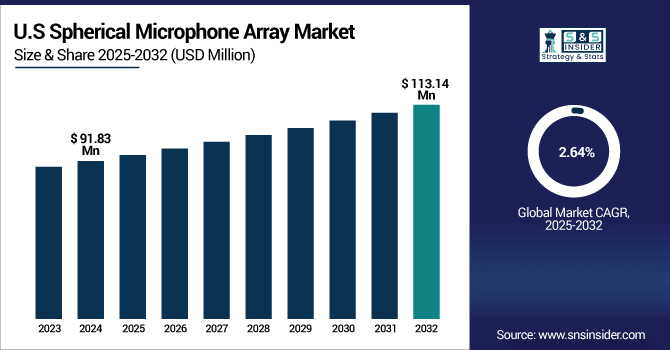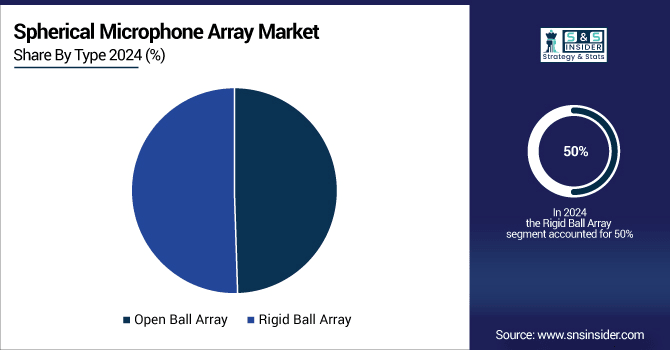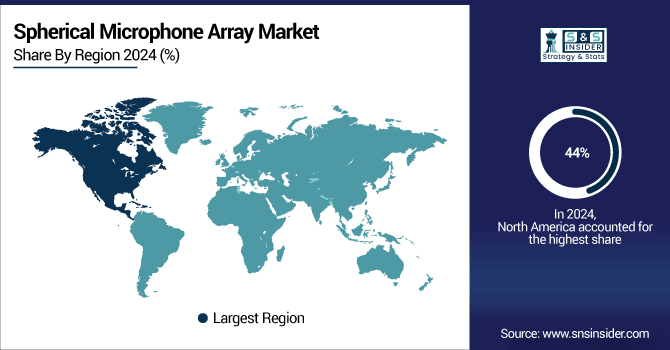Spherical Microphone Array Market Size Analysis:
The Spherical Microphone Array Market size was valued at USD 613.6 Million in 2024 and is projected to reach USD 876.86 Million by 2032, growing at a CAGR of 4.57% during 2025-2032.

To Get More Information On Spherical Microphone Array Market - Request Free Sample Report
The spherical microphone array market is growing at a faster pace with major application in automotive, aerospace, telecommunication and smart devices. These arrays offer the best audio capture and sound specialization far-field processing techniques that are crucial for far-field voice recognition, noise cancellation, and immersive audio experiences. Progression Market development is posed to occur on account of technological inroads and uptake across robotics, virtual reality, and defense industries. Furthermore, investments in R&D and advancements in miniaturization and signal processing technologies are aiding in the improvement of the performance and cost effectiveness of the spherical microphone arrays, thus resulting in consistent global market gains.
China has unveiled all-terrain, spherical robo-cops equipped with AI and net-launching cannons to detect, chase, and capture criminals. These unbreakable robotic spheres are now rolling through cities, enhancing urban security with advanced crime-fighting capabilities.
The U.S Spherical Microphone Array Market was valued at USD 91.83 Million in 2024 and is projected to reach USD 113.14 Million by 2032, growing at a CAGR of 2.64% during 2025-2032, is due to growing need for the high quality audio capture in automotive, aerospace, and consumer electronics. The spherical microphone array market growth is influenced by the development of voice recognition, noise cancellation and immersive audio technologies, as well as the increasing penetration of smart devices and robotics in several end-markets.

Spherical Microphone Array Market Dynamics:
Drivers:
-
Advancements in Spatial Audio Technologies Drive Increased Demand for Spherical Microphone Arrays
The spherical microphone array market is expanding due to the rising demand for immersive and spatial audio technologies that provide accurate 3D sound capture and playback. Advancements in virtual mixing spaces and binaural audio processing will allow for details and more realistic soundscapes, with a growing necessity for these sound experiences in entertainment, educational and professional audio environments. As consumers and industries demand increasingly immersive audio experiences for gaming, virtual reality (VR), and live content, the market for spherical microphone arrays is experiencing rapid expansion. These arrays are essential in a geometry that allows capturing to be accurate to the location of the sound in space and are key in delivering the highest quality in the immersive sound experience. This growing penetration in a number of industries is a crucial aspect of the growth of the global spherical microphone array market.
Sony Electronics showcased its latest audio innovations, including the 360 Virtual Mixing Environment (360VME) and immersive 360 Reality Audio, at the 2024 NAMM Show. This technology is now integrated into educational programs like Blackbird Academy, enhancing audio learning experiences.
Restraints:
-
Limited Awareness and Understanding in Industries Hinders Adoption and Slows Market Growth of Spherical Microphone Arrays
Limited industry awareness of the benefits and applications of spherical microphone arrays is a significant restraint on market growth. Most potential users don’t understand the ways in which these audio capture technologies can improve spatial sound precision and immersion. This knowledge is little known, and adoption takes longer in areas like entertainment, education, and pro audio. Therefore, conventional microphones and audio systems are still the main approaches used in enterprises, which becomes an obstacle for the popularization of the spherical microphone array system. To address this, more efforts are needed in education, marketing and demonstration to demonstrate the array’s potential and to promote wider acceptance, which will lead to the acceleration of market penetration and growth.
Opportunities:
-
Rising Demand for Immersive Audio Drives Advancements in Higher-Order Ambisonics, Accelerating Growth of the Spherical Microphone Array Market
The spherical microphone array market is poised for significant growth due to increasing demand for precise 3D audio capture enabled by higher-order Ambisonics technology. Higher resolution in space follows the move to immersive audio experience that are applied in virtual reality and gaming as well as broad and scientific market such as broadcasting and acoustic research etc. With the increasing demand for realistic and immersive sound environments in various sectors, the use of higher-order spherical arrays is being driven. Moreover growing uses in automotive noise cancellation, smart devices and monitoring live events are offering new market opportunities. Advances in hardware design and software integration will continue to increase the power and multiuse flexibility of these arrays, opening up new applications and facilitating adoption on a broadening range of applications worldwide.
mh acoustics launched the Eigenmike em64, a state-of-the-art spherical microphone array featuring 64 omnidirectional microphones for enhanced higher-order Ambisonics soundfield capture. This innovation doubles the microphone count of its predecessor, enabling superior 3D audio recording and analysis.
Challenges:
-
Lack of Standardization Limits Interoperability and Slows Adoption of Spherical Microphone Arrays
The absence of universally accepted standards for spherical microphone array formats and output signals presents a significant challenge in the market. In the absence of unified protocols, they being different and seemingly non-compatible between products by different manufacturers plague integration. This fragmentation not only prevents the seamless transfer and collaboration of information across platforms, but also creates obstacles to developers and users. This has made some potential customers shy away from using spherical microphone arrays, because of fear that the technology will not remain up to date for long, and that they will be locked into using one vendor. This lack of standardization also inhibits innovation, as interoperable software and hardware solutions are not so easily created. This is a key hurdle to improve across-the-board acceptance, provide for wider-spread use and realize the benefits of spherical microphone technologies in a multitude of applications.
Spherical Microphone Array Market Segmentation Outlook:
By Type
The Rigid Ball Array segment held a dominant Spherical Microphone Array Market share of around 50% in 2024, All of this enables extreme tolerance to pressure and uniform spatial audio capture, with negligible traces of distortion, which is valuable for industries such as automotive, aerospace and high-end audio. This trust increases the penetration rate in markets for accurate 3D sound recording.

The Open Ball Array segment is expected to experience the fastest growth in the Spherical Microphone Array Market over 2025-2032 with CAGR 6.99%. Drives from its lightweight construction and improved acoustic transparency, which facilitate a more accurate soundfield pick up. Its versatility and price makes it a great tool for research and applications of virtual reality and immersive audio; it is gaining popularity in universities and innovative audio companies.
By Application
The Aviation Field segment held a dominant Spherical Microphone Array Market share of around 47% in 2024 and expected to be fastest growing during 2024-2032 with CAGR 5.58%. Due to increasing need for in-depth acoustic assessment in airplanes. These arrays allow accurate 3D sound mapping necessary for cabin noise reduction, state-of-the-art pilot communication systems, and comfort improvements for the passengers, which are key features for commercial aviation as well as in aero spatial research activities
Spherical Microphone Array Market Regional Analysis:
In 2024, the North America dominated the Spherical Microphone Array market and accounted for 44% of revenue share, due to virtual reality, gaming, aerospace, and defense industry demands increasing. Spates of strong technological infrastructure in the region are continually fostering research in the spatial audio space, in addition to integration of 3D audio technology in consumer electronics, entertainment, and smart communication systems thereby driving sales.

Get Customized Report as Per Your Business Requirement - Enquiry Now
The U.S. dominates the spherical microphone array market due to strong demand from defense, aerospace, and entertainment sectors, supported by advanced R&D infrastructure and widespread adoption of immersive audio technologies.
Asia-Pacific is projected to register the fastest CAGR of 7.10% during 2025–2032 in the spherical microphone array market, fueled by growing adoption of immersive audio in consumer electronics, expanding gaming and VR industries, rising investments in smart technologies, and increasing government support for advanced acoustic research and development across the region.
In 2024, Europe emerged as a promising region in the Spherical Microphone Array market, owing to large investments in audio technology R&D sector, the presence of an automotive and aerospace industry in the region and the growing application of spatial audio in the media production. The increasing need for advanced sound captivation solutions and government support also accelerate the regional market growth.
LATAM and MEA is experiencing steady growth in the Spherical Microphone Array market, as the investment on telecommunication is rising in the region, upsurge in adoption of advanced audio technologies in media & entertainment and increasing aerospace and defense industry. This is further boosting market penetration and product innovation in the nascent markets, which are enjoying specific support from government legislation.
Key Players:
The Spherical Microphone Array Market Companies are HBK, RION, Sony, SKC Acoustics Technology, Beijing Shengwang Acoustic-Electric Technology, Shenzhen Feitengyun Technology, Beijing Zhongke Huiyi Technology, Shenzhen Feisheng Technology, and Hangzhou AIHUA Instruments and Others.
Recent News
-
In Jan 2024, HOLOPLOT unveiled its compact X2 Matrix Array at ISE 2024, enhancing immersive spatial audio with advanced spherical microphone technology. Powersoft introduced new cloud-based audio management tools for remote sound system control.
| Report Attributes | Details |
|---|---|
| Market Size in 2024 | USD 613.6 Million |
| Market Size by 2032 | USD 876.86 Million |
| CAGR | CAGR of 4.57% From 2025 to 2032 |
| Base Year | 2024 |
| Forecast Period | 2025-2032 |
| Historical Data | 2021-2023 |
| Report Scope & Coverage | Market Size, Segments Analysis, Competitive Landscape, Regional Analysis, DROC & SWOT Analysis, Forecast Outlook |
| Key Segments | • By Type (Open Ball Array, Rigid Ball Array) • By Application (Aviation Field, Automotive Field and Other) |
| Regional Analysis/Coverage | North America (US, Canada, Mexico), Europe (Germany, France, UK, Italy, Spain, Poland, Turkey, Rest of Europe), Asia Pacific (China, India, Japan, South Korea, Singapore, Australia, Taiwan, Rest of Asia Pacific), Middle East & Africa (UAE, Saudi Arabia, Qatar, South Africa, Rest of Middle East & Africa), Latin America (Brazil, Argentina, Rest of Latin America) |
| Company Profiles | The Spherical Microphone Array market companies are HBK, RION, Sony, SKC Acoustics Technology, Beijing Shengwang Acoustic-Electric Technology, Shenzhen Feitengyun Technology, Beijing Zhongke Huiyi Technology, Shenzhen Feisheng Technology, and Hangzhou AIHUA Instruments and Others. |

